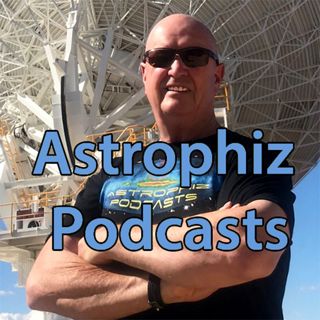Om avsnittet
Astrophiz 197: Dt Ian Musgrave’s August SkyGuide Moon Phases for August New Moon - 4 August - best for seeing the faint fuzzies and clusters Apogee Moon furthest from Earth - 9 August 1st Quarter Moon - 13 August Full Moon - 20 August Perigee Moon closest to Earth - 21 August Last Quarter Moon - 26 August Evening Sky Comet C/2023 A3 Tsuchinshan is binocular-visible in Leo. Mercury is a fine sighting early in the evenings in August near the Western horizon. Mercury, Regulus and Venus are visible till an hour after sunset On the 6th, Mercury, Regulus and Venus form a triangle with the thin crescent moon. Venus is climbing higher and becoming more prominent as the ‘Evening Star' Saturn is rising about 8:30 in the evening and is best telescopically a few hours later when it is higher. Saturns Rings are almost edge on at the moment. Morning Sky Mars has been heading towards Jupiter and the horizon, and in the first week of August lands in the constellation Taurus, forming a second red ‘eye’ with Aldabaran in the bull's head. Between the 12th and 17th Mars and Jupiter are less than a finger width apart, and on the 15th, less than half a finger width apart. Looking East and North East in the morning, the Pliades Cluster, Hyades Cluster, Mars, Jupiter and Aldabaran are making interesting patters throughout the month. Capturing a recurrent Nova Explosion About an hour and a half after sunset when the sky is completely dark, you look North and a little bit West, you’ll spot the bright star Arcturus, then if you look down and a little to the right, you’ll see a circle of stars called Corona Borealis. The Astrophotography Challenge Take a photo of Corona Borealis every clear night during August-September to capture the pre-Nova view and then continue till after TCR-B has gone Nova. Ian’s Tangent : How do we define a planet? We have a definition of a solar system planet: Forms a sphere under its own gravity. It must orbit our sun. It must have cleared its own orbit Now because we cannot yet determine if an exoplanet is a sphere, we now have a proposed definition of an exoplanet, It must orbit a sun, or suns. Its mass must be smaller than can have fusion occurring Its mass must be enough to clear its orbit. Yesterday the ESA released an image of a ‘Cold Jupiter’ named Epsilon Indi Ab. The planet is several times the mass of Jupiter and orbits the K-type star Epsilon Indi A (Eps Ind A), which is around the age of our Sun, but slightly cooler. The team observed Epsilon Indi Ab using the coronagraph on Webb’s MIRI (Mid-Infrared Instrument). Of the 5000+ exoplanets known to date, only a few tens of exoplanets have been directly imaged previously by space- and ground-based observatories. "This discovery is exciting because the planet is quite similar to Jupiter — it is a little warmer and is more massive, but is more similar to Jupiter than any other planet that has been imaged so far,” quoted lead author Elisabeth Matthews of the Max Planck Institute for Astronomy in Germany.

